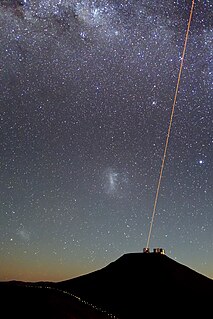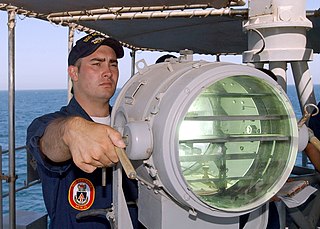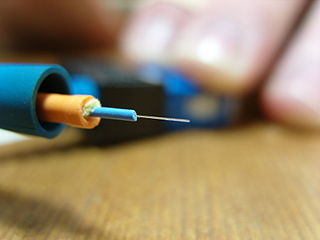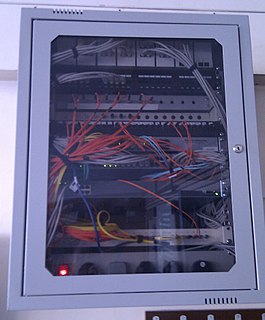Related Research Articles

An optical amplifier is a device that amplifies an optical signal directly, without the need to first convert it to an electrical signal. An optical amplifier may be thought of as a laser without an optical cavity, or one in which feedback from the cavity is suppressed. Optical amplifiers are important in optical communication and laser physics. They are used as optical repeaters in the long distance fiberoptic cables which carry much of the world's telecommunication links.

In telecommunications, a repeater is an electronic device that receives a signal and retransmits it. Repeaters are used to extend transmissions so that the signal can cover longer distances or be received on the other side of an obstruction. Some types of repeaters broadcast an identical signal, but alter its method of transmission, for example, on another frequency or baud rate.

In fiber-optic communications, wavelength-division multiplexing (WDM) is a technology which multiplexes a number of optical carrier signals onto a single optical fiber by using different wavelengths of laser light. This technique enables bidirectional communications over a single strand of fiber, also called wavelength-division duplexing, as well as multiplication of capacity.

Optical communication, also known as optical telecommunication, is communication at a distance using light to carry information. It can be performed visually or by using electronic devices. The earliest basic forms of optical communication date back several millennia, while the earliest electrical device created to do so was the photophone, invented in 1880.

Photonics is the physical science and application of light (photon) generation, detection, and manipulation through emission, transmission, modulation, signal processing, switching, amplification, and sensing. Though covering all light's technical applications over the whole spectrum, most photonic applications are in the range of visible and near-infrared light. The term photonics developed as an outgrowth of the first practical semiconductor light emitters invented in the early 1960s and optical fibers developed in the 1970s.

A cable television headend is a master facility for receiving television signals for processing and distribution over a cable television system. A headend facility may be staffed or unstaffed and is typically surrounded by some type of security fencing. The building is typically sturdy and purpose-built to provide security, cooling, and easy access for the electronic equipment used to receive and re-transmit video over the local cable infrastructure. One can also find head ends in power-line communication (PLC) substations and Internet communications networks.
Hybrid fiber-coaxial (HFC) is a telecommunications industry term for a broadband network that combines optical fiber and coaxial cable. It has been commonly employed globally by cable television operators since the early 1990s.
A passive optical network (PON) is a fiber-optic telecommunications technology for delivering broadband network access to end-customers. Its architecture implements a point-to-multipoint topology in which a single optical fiber serves multiple endpoints by using unpowered (passive) fiber optic splitters to divide the fiber bandwidth among the endpoints. Passive optical networks are often referred to as the last mile between an Internet service provider (ISP) and its customers.

Multi-mode optical fiber is a type of optical fiber mostly used for communication over short distances, such as within a building or on a campus. Multi-mode links can be used for data rates up to 100 Gbit/s. Multi-mode fiber has a fairly large core diameter that enables multiple light modes to be propagated and limits the maximum length of a transmission link because of modal dispersion. The standard G.651.1 defines the most widely used forms of multi-mode optical fiber.

An optical fiber is a flexible, transparent fiber made by drawing glass (silica) or plastic to a diameter slightly thicker than that of a human hair. Optical fibers are used most often as a means to transmit light between the two ends of the fiber and find wide usage in fiber-optic communications, where they permit transmission over longer distances and at higher bandwidths than electrical cables. Fibers are used instead of metal wires because signals travel along them with less loss; in addition, fibers are immune to electromagnetic interference, a problem from which metal wires suffer. Fibers are also used for illumination and imaging, and are often wrapped in bundles so they may be used to carry light into, or images out of confined spaces, as in the case of a fiberscope. Specially designed fibers are also used for a variety of other applications, some of them being fiber optic sensors and fiber lasers.
Ciena Corporation is an American telecommunications networking equipment and software services supplier based in Hanover, Maryland. The company has been described by The Baltimore Sun as the "world's biggest player in optical connectivity." The company reported revenues of $3.57 billion for 2019. Ciena had approximately 6,000 employees, as of October 2018. Gary Smith serves as president and chief executive officer (CEO).
Optical networking is a means of communication that uses signals encoded in light to transmit information in various types of telecommunications networks. These include limited range local-area networks (LAN) or wide-area networks (WAN), which cross metropolitan and regional areas as well as long-distance national, international and transoceanic networks. It is a form of optical communication that relies on optical amplifiers, lasers or LEDs and wave division multiplexing (WDM) to transmit large quantities of data, generally across fiber-optic cables. Because it is capable of achieving extremely high bandwidth, it is an enabling technology for the Internet and telecommunication networks that transmit the vast majority of all human and machine-to-machine information.

Light tubes are physical structures used for transmitting or distributing natural or artificial light for the purpose of illumination, and are examples of optical waveguides.
American Photonics, Inc. (API) was a very early developer of local area network technologies in the 1980s, based first in Brewster, New York, moving later to Brookfield Center, Connecticut.

Fiber-optic communication is a method of transmitting information from one place to another by sending pulses of infrared light through an optical fiber. The light is a form of carrier wave that is modulated to carry information. Fiber is preferred over electrical cabling when high bandwidth, long distance, or immunity to electromagnetic interference is required. This type of communication can transmit voice, video, and telemetry through local area networks or across long distances.

Telecommunications Engineering is an engineering discipline centered on electrical and computer engineering which seeks to support and enhance telecommunication systems. The work ranges from basic circuit design to strategic mass developments. A telecommunication engineer is responsible for designing and overseeing the installation of telecommunications equipment and facilities, such as complex electronic switching systems, and other plain old telephone service facilities, optical fiber cabling, IP networks, and microwave transmission systems. Telecommunications engineering also overlaps with broadcast engineering.
Kevin Kimberlin is chairman of Spencer Trask & Co., an advanced technology firm. Kimberlin has distinguished himself by partnering with or backing "obsessive missionaries" including Jonas Salk, Walter Gilbert, John Wennberg and Robert Langer.
Radio over fiber (RoF) or RF over fiber (RFoF) refers to a technology whereby light is modulated by a radio frequency signal and transmitted over an optical fiber link. Main technical advantages of using fiber optical links are lower transmission losses and reduced sensitivity to noise and electromagnetic interference compared to all-electrical signal transmission.
Mindspeed Technologies, Inc. designs, manufactures, develops, and sells fabless semiconductors for communications applications in wireless and wired networks.
David R. Huber is an American engineer specializing in optical networking. He is the holder and assignor of several patents in the field of optical transmission, distribution, and communication.
References
- ↑ "Optelecom-NKF, Inc". Bloomberg.
- ↑ "Optelecom Chairman Announces Retirement". The Baltimore Sun. January 10, 1998.
- ↑ "Gordon Gould". Our Biography.
- ↑ "Culver, William. Notice". The Washington Post. November 22, 2016.
- ↑ Jones, Stacy V. (October 15, 1977). "Patents". New York Times.
- ↑ Taylor, Nick (2000). Laser: The Inventor, The Nobel Laureate, and The Thirty-Year Patent War. Simon & Schuster. p. 69. ISBN 978-0684835150.
- ↑ Glaab, J.B; Huber, D.R. (October–December 1990). "Optical Amplifiers for Video Distribution". International Journal of Digital & Analog Communication Systems. 3 (4): 333–339. doi:10.1002/dac.4510030408.
- ↑ Auerweck, Steve (May 17, 1993). "Optelecom, HydraLite become partners Optelecom Inc. of Gaithers...". The Baltimore Sun.
- ↑ Auerweck, Steve (May 17, 1993). "Optelecom, HydraLite become partners Optelecom Inc. of Gaithers...". The Baltimore Sun.
- ↑ "Optelecom to Acquire NKF Electronics". Photonics Media. February 2005.
- ↑ "TKH Group NV to Acquire Optelecom NKF, Inc". Cision PR Newswire. November 11, 2010.